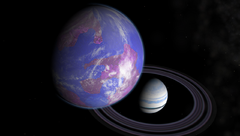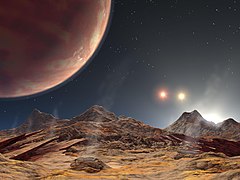Egzoksiężyc


Egzoksiężyc – naturalny satelita orbitujący wokół planety pozasłonecznej lub innego podobnego obiektu nieznajdującego się w Układzie Słonecznym. Biorąc pod uwagę istnienie licznych księżyców w naszym układzie planetarnym, wnioskuje się, że najprawdopodobniej istnieją one także wokół wielu innych planet pozasłonecznych. Większość dotychczas odkrytych planet pozasłonecznych należy do typu gazowych olbrzymów, które w Układzie Słonecznym mają liczne naturalne satelity (zobacz listy naturalnych satelitów Jowisza i Saturna)[1].
Wykrycie egzoksiężyców przy użyciu obecnych technologii jest niezmiernie trudne, ale jest uważane za możliwe[2]. W 2012 roku rozpoczęto projekt badawczy The Hunt for Exomoons with Kepler mający na celu poszukiwanie księżyców pozasłonecznych z użyciem obserwacji Kosmicznego Teleskopu Keplera[3]. Jest to pierwsze tego typu przedsięwzięcie naukowe[4].
Możliwe jest, że istnieją egzoksiężyce o innych właściwościach fizycznych niż księżyce Układu Słonecznego. Rozważa się na przykład istnienie dużych, podobnych do Ziemi księżyców gazowych olbrzymów znajdujących się w ekosferze, na powierzchni których może istnieć życie (ang. habitable moon)[5].
Do wykrywania egzoksiężyców może być użytych kilka sposobów podobnych do tych, jakie są stosowane przy wykrywaniu planet pozasłonecznych, na przykład:
Potencjalne egzoksiężyce
- MOA-2011-BLG-262 (obiekt egzoplaneta-egzoksiężyc)[10]
- naturalny satelita egzoplanety Kepler-1625b[11][12]
- naturalny satelita egzoplanety WASP-49b[13][14]
Przypisy
- ↑ C. G. Tinney i inni. The Anglo-Australian Planet Search. XXI. A Gas-giant Planet in a One Year Orbit and the Habitability of Gas-giant Satellites. „The Astrophysical Journal”. 732 (1), 2011 (ang.). [dostęp 2012-01-30].
- ↑ David M. Kipping, Transit timing effects due to an exomoon, „Monthly Notices of the Royal Astronomical Society”, 392 (1), 2008, s. 181-189, DOI: 10.1111/j.1365-2966.2008.13999.x, arXiv:0810.2243 [astro-ph] (ang.).
- ↑ J. Voisey: Exomoons? Kepler's On The Hunt (ang.). Universe Today, 2012-01-06. [dostęp 2012-01-06].
- ↑ Hunt for Exomoons with Kepler (ang.). cfa.harvard.edu. [dostęp 2013-12-30]. [zarchiwizowane z tego adresu (2013-12-30)].
- ↑ Robin M. Canup, William R. Ward: A common mass scaling for satellite systems of gaseous planets (ang.). Nature, 2006-05-26. [dostęp 2012-01-06].
- ↑ Cheongho Han, Wonyong Han, On the Feasibility of Detecting Satellites of Extrasolar Planets via Microlensing, „The Astrophysical Journal”, 580 (1), 2002, s. 490-493, DOI: 10.1086/343082, arXiv:astro-ph/0207372 [dostęp 2017-01-14] (ang.).c?
- ↑ A. Simon, K. Szatmary, G.M. Szabo, Determination of the size, mass, and density of "exomoons" from photometric transit timing variations, „Astronomy & Astrophysics”, 470 (2), 2007, s. 727-731, DOI: 10.1051/0004-6361:20066560, arXiv:0705.1046 [astro-ph] [dostęp 2017-01-14] (ang.).
- ↑ J. Cabrera, J. Schneider, Detecting companions to extrasolar planets using mutual events, „Astronomy & Astrophysics”, 464 (3), 2007, s. 1133-1138, DOI: 10.1051/0004-6361:20066111, arXiv:astro-ph/0703609 [dostęp 2017-01-14] (ang.).
- ↑ Karen M. Lewis, Penny D. Sackett, Rosemary A. Mardling, Possibility of Detecting Moons of Pulsar Planets Through Time-of-Arrival Analysis, „The Astrophysical Journal Letters”, 685 (2), 2008, s. L153-L156, DOI: 10.1086/592743, arXiv:0805.4263 [astro-ph] [dostęp 2017-01-14] (ang.).
- ↑ John Moll: Astronomowie twierdzą, że odkryli pierwszy egzoksiężyc. tylkonauka.pl, 26 grudnia 2013. [dostęp 2018-10-04].
- ↑ Mariusz Błoński: Odkryto pierwszy egzoksiężyc?. Kopalnia Wiedzy, 2018-10-04. [dostęp 2018-10-04].
- ↑ Rafał Grabiański: Naukowcy przedstawiają dowody na pierwszy odkryty egzoksiężyc. Urania – Postępy Astronomii, 2018-10-03. [dostęp 2018-10-04].
- ↑ Radek Kosarzycki: Wulkanicznie aktywny egzoksiezyc krążący wokół WASP-49?. Puls Kosmosu, 2019-08-30. [dostęp 2019-09-01].
- ↑ Passant Rabie: Scientists May Have Found a Volcanic Exomoon That Darth Vader Could Call Home WASP-49. Space.com, 2019-08-31. [dostęp 2019-09-01].
Linki zewnętrzne
Media użyte na tej stronie
Autor: Frizaven on English Wikipedia (Originally uploaded on 19:09, 20 March 2006), Licencja: GPL
A hypothetical rendition of the Blue Moon created by "Frizaven" on the 3D Space Simulator Celestia, Celestia is copyright free.
Artist's conception of the three suns and the newly discovered Jupiter-sized planet from the perspective of a hypothetical moon orbiting the planet. The large yellow sun is already halfway over the horizon. The orange and red suns are still visible in the sky. This artist's animation shows the view from a hypothetical moon in orbit around the first known planet to reside in a tight-knit triple-star system. HD 188753 Ab is a gas giant planet, about 1.14 times the mass of Jupiter, with an orbital period of 3.3 days discovered using the Keck I telescope atop Mauna Kea in Hawaii, and zips around a single star that is orbited by a nearby pair of pirouetting stars. Because the stars in this triple system are bunched together, sunsets on the planet -- or on any moons that might exist around the planet -- would be spectacular. This rambunctious stellar family is called HD 188753 and is located 149 light-years away in the constellation Cygnus.
In this movie, sunset is seen through the tenuous atmosphere of a hot, baked hypothetical moon. As the suns dip below the horizon, the gas giant comes into view. The moon's landscape remains illuminated by sunlight reflected off the planet. Both the planet and moon would be so hot that even in shadow their surfaces would glow.
The suns' colors and sizes reflect their masses, temperatures and distances to the planet. For example, the first star shown setting over the horizon is the closest, most massive and hottest of the trio, so it is depicted as large and white. The second star is farther away, less massive and cooler than the first, appearing smaller and yellow. The final star is at the same distance as the second, but it is still less massive and cooler, appearing even smaller and orange-red in color. Our Sun is a bit cooler than the hottest star of the system.
The graph in figure 1 shows the "wobble" of a star being tugged on by the planet called HD 188753 Ab. The planet was discovered via the radial velocity technique, in which a planet's presence is inferred by the motion, or wobble, it causes in its parent star. Stellar motion is plotted here as changes in velocity (y-axis) versus time (x-axis).
Unlike most planetary wobbles, this one comes from a star that is circled by a nearby pair of stars. In other words, the planet orbits a single star that is part of a close-knit triple-star system. Because the starlight from this cramped bunch blends together, the task of sifting through the light to find the planet's signature was more difficult. This challenge was overcome with the help of detailed models of the triple-star system's light. Data from those models resulted in precise velocity measurements of the star circled by HD 188753 Ab.
Note: The size of the Full-Res TIFF for the still image is 3200 samples x 2400 lines.
